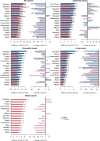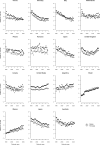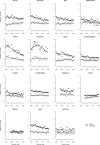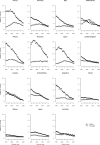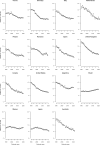Trends in cancer mortality under age 50 in 15 upper-middle and high-income countries
- PMID: 39576674
- PMCID: PMC11972687
- DOI: 10.1093/jnci/djae288
Trends in cancer mortality under age 50 in 15 upper-middle and high-income countries
Abstract
Background: Rising cancer incidence, particularly for colorectal cancer, has been reported in young adults. This study examined whether this is related to an increase in mortality.
Methods: We analyzed World Health Organization mortality data among young adults aged 25-49 years in 15 most populous upper-middle and high-income countries from 1990 to 2021 with reliable data. Midyear populations were retrieved from the United Nations for the American Countries and from the World Health Organization for the other countries. We compared age-standardized mortality rates in 2019-2021 with those in 2009-2011 and performed joinpoint regression analysis for all cancers and selected most common cancer sites: colorectum, pancreas, lung, and breast.
Results: In 2019-2021, the highest age-standardized mortality rates (per 100 000) were in Romanian males (38.6) and Argentinian females (45.9), while the lowest ones were in Japanese males (16.3) and females (22.7). Age-standardized mortality rates for colorectal cancers increased in 2019-2021 compared with 2009-2011 in 9 countries among men and in 7 countries among women. The highest increases were in the United Kingdom (males: +26.1%; females: +33.7%), Canada (males: +25.3%), and Mexico (males: +33.5%; females: +29.7%). Long-term analysis over the last 3 decades showed declining trends in total cancer mortality in the majority of countries, in lung cancer mortality across all countries, and in breast cancer in all countries except in Latin America.
Conclusions: Although mortality from common cancers has generally decreased over the past 3 decades, mortality from colorectal cancer has increased in some countries. This highlights the need to control the obesity epidemic and implement targeted surveillance strategies in young populations.
© The Author(s) 2024. Published by Oxford University Press.
Conflict of interest statement
The authors declare that they have no known competing interests.
Figures
